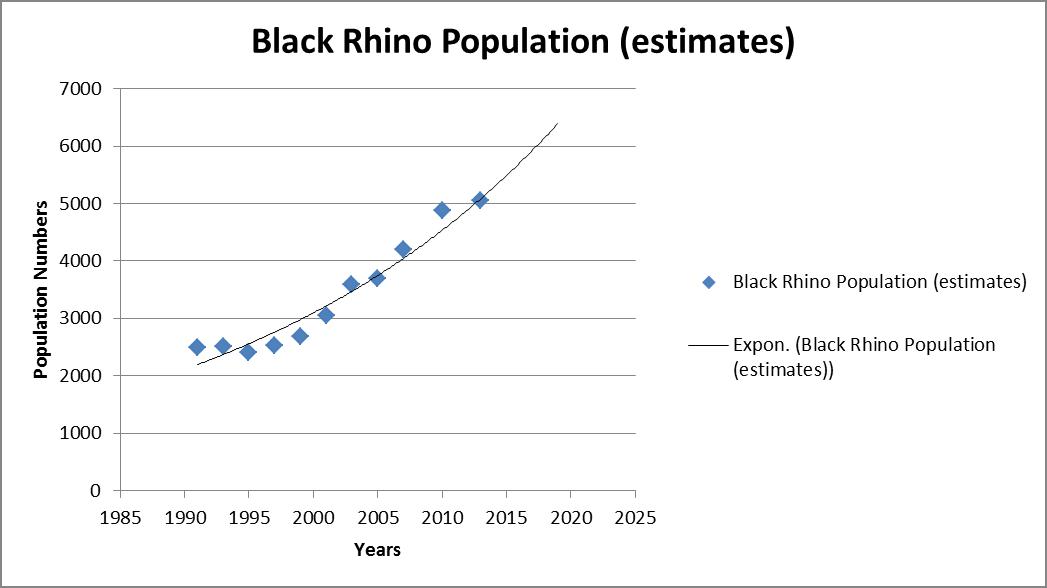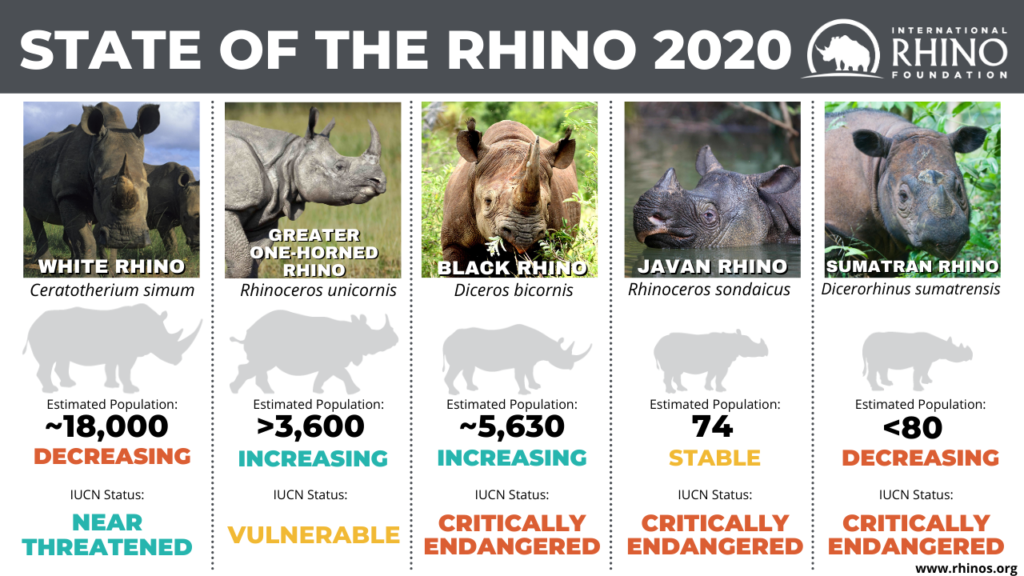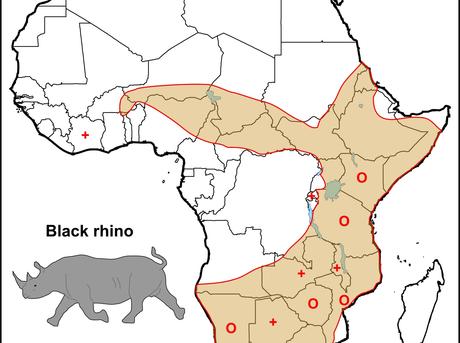To protect black rhinos from poaching and habitat loss WWF is taking action in three African rhino range countries. The International Union for Conservation of Nature IUCN said in an update.
 Rhino Populations Rhino Facts Save The Rhino International
Rhino Populations Rhino Facts Save The Rhino International
Black rhino Diceros bicornis Intensive anti-poaching efforts have had encouraging results since 1993 and the population now numbers around 5630 in the wild.

Black rhino population. Rhino is commonly seen as an abbreviation of rhinoceros one of the five existing species of survivors. Namibia Kenya and South Africa. The south-western black rhino a subspecies of the black rhino has seen sufficient population growth over the last three generations to be newly categorised as Near Threatened the IUCN said.
Rampant poaching reduced the total population to some 2400 by 1995 but since then conservation efforts have brought the numbers up to approximately 4800. Ol Pejeta now has a population of 132 black rhinos as of mid December 2019 as well as a growing population of southern white rhinos currently standing at 35 individuals in addition to the. The numbers of African black rhinos is slowly rising thanks to the efforts of conservationists new figures have shown.
Since 2012 the population has grown by more than 11 up to a total population of 2188 individuals in 2017 when the most recent data was published. The western black rhino emerged about 7 to 8 million years ago. But the other two surviving subspecies the South-eastern and Eastern both remain Critically Endangered due to drastic declines between the 1970s and 1990s.
African and Asian Rhino Specialist Groups AfRSG other sources. Populations of black rhino have been decimated over recent years. The population declined by 95 from 1960 plummeting from more than 65000 individuals to fewer than 2500 animals in 1995 as poaching for rhino horn and land clearance decimated the species.
Estimated number of black rhinos. For much of the 1900s its population was the highest out of all the rhino species at almost 850000 individuals. Thanks to the persistent efforts of conservation programmes across Africa black rhino numbers have risen since then to a current population of between 5366 and 5627 individuals.
It is thought that as recently as 1970 there were as many as 65000 black rhinos in the wild. Large-scale poaching saw black rhino populations decline from around 70000 individuals in 1970 to just 2410 in 1995 thats a dramatic decline of 96 over 20 years. By the mid 1990s the black rhino was on the brink of extinction and there was a desperate need for more dedicated conservation efforts.
Some estimates put their numbers at more than one million individuals. This subspecies of black rhino one of three surviving subspecies is found in mainly in Namibia as well as South Africa. So what actions have led to this success.
There was a 96 population decline in black rhinos including the western black rhino between 1970 and 1992. It was a sub-species of the black rhino. Rhino population found significant to estimate their number.
The curve has now turned and the population stands at 750 in 2018. As of 2013 the southern subspecies has a wild population of 20405 making the black. The Black Rhino has suffered a catastrophic 98 decline across Kenya whose population plummeted from 20000 in 1970 to about 350 in 1983.
Ol Pejeta now has a population of 132 black rhinos as of mid December 2019 as well as a growing population of southern white rhinos currently standing at 35 individuals in addition to the remaining two female northern white rhinos. 1960 1970 1980 1990 2000 2010 2017 0 20000 40000 60000 80000 100000 World. According to the IUCN International Union for Conservation of Nature the black rhino population has risen from 2500 in the mid-nineties to just over 5600 today.
The eastern black rhino Diceros bicornis michaeli is the most endangered of the surviving black rhino subspecies with fewer than 950 individuals remaining. Thanks to persistent conservation efforts across Africa the total number of black rhinos grew from 2410 in 1995 to more than 5000 today. Black rhinoceroses were abundant about 1900.
The increase in black rhino population is due to the commitment and passion of both private rhino conservationists and government input.
 Population Growth Black Rhinoceros
Population Growth Black Rhinoceros
 Concurrent Changes In Population Size And Level Of Poaching In Black Download Scientific Diagram
Concurrent Changes In Population Size And Level Of Poaching In Black Download Scientific Diagram
 Black Rhinoceros Saint Louis Zoo
Black Rhinoceros Saint Louis Zoo
 Black Rhino Population Estimates For 1933 2000 A And Growth Rates For Download Scientific Diagram
Black Rhino Population Estimates For 1933 2000 A And Growth Rates For Download Scientific Diagram
The Black Rhino Emerald Insight
 The Alarming Decline Of Black Rhino Population In South Africa The Awakened Environmentalists
The Alarming Decline Of Black Rhino Population In South Africa The Awakened Environmentalists
 Intlrhinofoundation Sur Twitter If The Black Rhino Population Has Been Increasing For 25 Years How Are They Still Criticallyendangered This Chart Should Give A Clue But It S More Than Pop
Intlrhinofoundation Sur Twitter If The Black Rhino Population Has Been Increasing For 25 Years How Are They Still Criticallyendangered This Chart Should Give A Clue But It S More Than Pop
 2019 State Of The Rhino Report 10 Year Improvement In World Rhino Populations Offers Cautious Hope The International Rhino Foundation Blog
2019 State Of The Rhino Report 10 Year Improvement In World Rhino Populations Offers Cautious Hope The International Rhino Foundation Blog
 Black Rhino Population Growth In South Africa Source Iucn Afrsg Download Scientific Diagram
Black Rhino Population Growth In South Africa Source Iucn Afrsg Download Scientific Diagram
 Conservation Efforts Slowly Reviving African Black Rhino Population Cgtn
Conservation Efforts Slowly Reviving African Black Rhino Population Cgtn
 The Mean Fertility Rate Of The Black Rhino Population At Download Scientific Diagram
The Mean Fertility Rate Of The Black Rhino Population At Download Scientific Diagram
 State Of The Rhino International Rhino Foundation
State Of The Rhino International Rhino Foundation


No comments:
Post a Comment
Note: Only a member of this blog may post a comment.